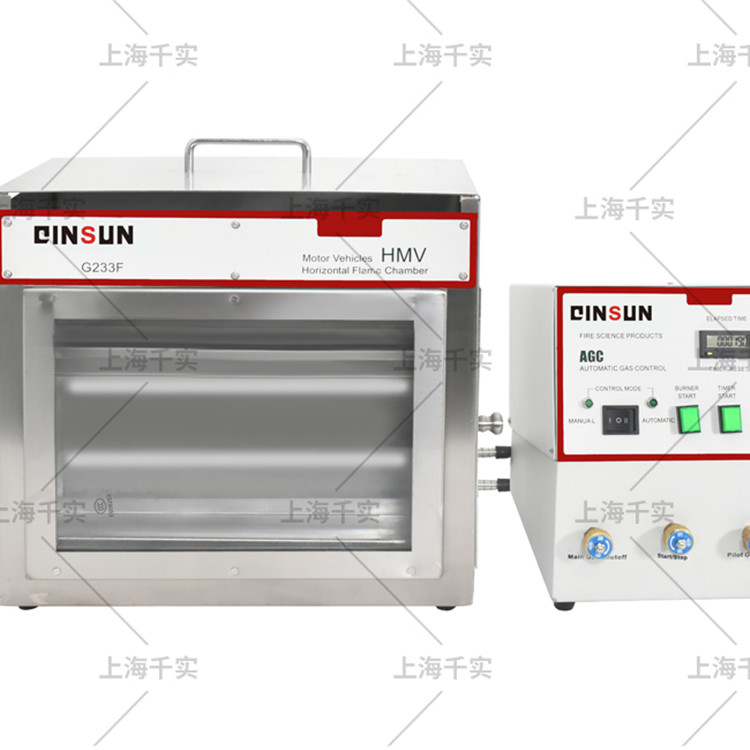
Standards compliant:
GB 8410, ISO 3795, FMVSS 302, DIN 75200, SAE J369, ASTM D5132, JIS D 1201, AU 169
Technical characteristics:
A, equipped with a sealed stainless steel combustion chamber and observation window, stainless steel is made of 316 type material, high temperature and high pressure resistance;
B. It adopts a suspended tympanic membrane structure with steel springs and a damping system for smooth operation;
C, equipped with sample holder and portal burner;
D, the basic mode is equipped with manual timing control;
E, the sample holder can move up and down and left and right;
F, equipped with automatic gas control system, including electromagnetic control gas valve, automatic ignition timer and controller.
technical parameter:
1. Flame application time: 0-999.9s±0.1s adjustable
2. Burning time: 0-99h59m59.99s±0.1s, manual start/pause
3. Combustion box installation: the bottom of the combustion box is 10mm from the bottom of the equipment
4. Test wind speed: the vertical air velocity of 100mm before and after the combustion box is between 0.10m/s~0.30m/s, and the anemometer is added to the right side of the equipment to monitor the outlet
5. U-shaped bracket: made of two U-shaped stainless steel plates, there are 2 pin holes at the rear of the upper bracket, and 2 pins corresponding to the lower bracket, and a heat-resistant metal support with a wire diameter of 0.25mm and a spacing of 25mm is arranged line
6. Gas lamp: the inner diameter is 9.5mm, and the center of the lamp mouth is 19mm below the center of the free end of the sample and can be automatically ignited
7. Gas: liquefied gas is used, and other combustible gases with a combustion heat value of 35MJ/m3~38MJ/m3 (such as natural gas, city gas) can also be used
8. Power supply: 220VAC-15%~220VAC+10% 500W (single-phase three-wire system)
Steps:
1. Take out the pretreated sample, place the fuzzed or tufted sample on a flat table, and comb it twice in the opposite direction of the fuzz with the specified metal comb on the fuzzing surface. When the air inlet of the gas lamp is closed, the gas lamp is ignited, and the flame is adjusted according to the flame height sign board, so that the flame height is 38mm. Before starting the first test, the flame should burn stably for at least 1 min in this state, and then extinguish. Load the specimen into the specimen holder with the exposed side facing down. Install the specimen so that both sides and one end are clamped by the U-shaped bracket, and the free end is aligned with the opening of the U-shaped bracket. When the width of the sample is insufficient, the U-shaped bracket cannot clamp the sample, or the free end of the sample is soft and easy to bend, which will cause unstable combustion, put the sample on the sample holder with heat-resistant metal wire for the combustion test .
2. Push the sample holder into the combustion box, and place the sample in the center of the combustion box in a horizontal position. Ignite the gas lamp with the air inlet of the gas lamp closed, and set the flame height to 38mm, keep the free end of the sample in the flame and ignite for 15s, and then extinguish the flame (close the gas lamp valve). The flame burns forward from the free end of the sample, and the timing starts when the root of the flame propagates through the * mark. Pay attention to the flame propagation on the faster side, and the timing is based on the side with faster flame propagation.
3. When the flame reaches the second mark or extinguishes before the flame reaches the second mark, stop the timing at the same time, and the timing shall also be based on the side where the flame spreads faster. If the flame goes out before reaching the second mark, measure the burning distance from the * mark to the time when the flame goes out. The burning distance refers to the length of the burned part of the sample surface or inside.
4. If the non-exposed surface of the sample is cut, the time should be based on the flame propagation speed of the exposed surface. The burning speed requirement does not apply to the surface formed by cutting the sample. If the sample burns slowly for a long time from the start of the timing, the test can be stopped when the test timing is 20 minutes, and the burning time and burning distance are recorded. When conducting a series of tests or repeated tests, the maximum temperature in the combustion chamber and the sample holder should not exceed 30°C before the next test.
5. Calculate the burning speed (V) as follows:
V=60×(L/T)
In the formula:
V--burning speed, in millimeters per minute (mm/min);
L---burning distance, in millimeters (mm).
For more information, please visit:
https://www.qinsun-lab.com/index.html
For more information, please visit:
https://www.qinsun-lab.com/index.html




